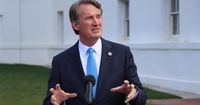Virginia is bracing for a wave of financial and social challenges as federal funding cuts, new program requirements, and shifting economic tides threaten to reshape the state’s budget and its social safety net. At the heart of the issue is a set of sweeping changes to federal programs such as Medicaid and the Supplemental Nutrition Assistance Program (SNAP), along with the knock-on effects of federal workforce reductions and grant cancellations. The state’s political leaders and fiscal experts are now grappling with the implications, debating both the scale of the problem and the best path forward.
On August 14, 2025, the Emergency Committee on the Impacts of Federal Workforce and Funding Reductions convened at Norfolk State University, hearing sobering presentations from legislative fiscal analysts and state officials. According to The Virginian-Pilot, Virginia will soon need to pay at least $90 million more each year in administrative costs for SNAP, as its share of the burden rises from 50% to 75% beginning in fiscal 2027. If the state’s current payment error rate holds steady, it could be on the hook for an additional $270 million annually in matching funds for SNAP by fiscal 2028.
David Reynolds, a legislative fiscal analyst, explained, “Budget action will be required no later than the 2027 General Assembly session in order to reflect these increased costs.” He added that the General Assembly will likely need to invest in new systems and personnel to drive down the error rate, which currently stands at 11.5%. If that error rate can be reduced below 6% before 2027, the state could avoid the extra financial burden. Governor Glenn Youngkin echoed this urgency, stating, “I firmly believe that if we can go to work with the localities and provide them with support resources, automation, we do have to change some of the rules which we can do... I think that will bring down error rates substantially.”
But SNAP isn’t the only program facing turbulence. Medicaid, a lifeline for hundreds of thousands of Virginians, is also undergoing significant changes. With the passage of new federal requirements, able-bodied adults enrolled in Medicaid will need to work, volunteer, or be enrolled in school starting in 2027. Eligibility redeterminations for the expansion population will shift from annual to every six months, increasing the administrative workload for the Department of Medical Assistance Services and local social services offices.
Governor Youngkin, presenting his fiscal overview to a joint meeting of the Virginia Senate and House appropriations committees, asserted, “Changes to Medicaid are not taking coverage away from anyone, and I want to say that again, not a single Virginian is losing access to Medicaid or getting kicked off the program.” He was unequivocal: “Not 40,000 Virginians, not whatever number someone else is saying on a given day, no Virginians are losing their Medicaid coverage.”
Yet, many lawmakers and health care advocates remain unconvinced. Democrats have cited estimates from the U.S. Senate’s Joint Economic Committee and the Congressional Budget Office suggesting that more than 322,000 Virginians could lose their health insurance due to the new requirements. Nationally, the Congressional Budget Office has projected that 4.8 to 5 million people could lose Medicaid coverage. Del. Candi Mundon King, D-Prince William, pointed to the example of Arkansas, where 18,000 people lost their coverage after similar work requirements were implemented in 2018. “I’m glad that you have confidence, but a lot of folks who are relying on us, especially to provide their health care, don’t feel confident,” King remarked.
Further complicating the landscape are changes to state health care funding mechanisms. The hospital assessment tax, which currently funds Medicaid expansion and boosts hospital reimbursements, will be reduced from 6% to 3.5% in 2032. While Reynolds noted that this won’t affect Virginia’s ability to fund Medicaid expansion, he warned, “These changes will reduce hospital revenues, which will be especially challenging for facilities currently operating at a loss.”
Healthcare isn’t the only area feeling the pinch. Higher education faces its own set of hurdles, with reductions in Pell Grant eligibility, caps on student borrowing, and the elimination of the Grad PLUS program for graduate and professional students. Starting in the 2028-2029 academic year, programs whose graduates aren’t earning at least the median income four years after graduation could lose access to the Federal Direct Loan program. If these provisions were in effect today, 39% of Virginia’s associate programs and 16% of bachelor’s programs would be at risk, according to Virginia Media.
On the economic front, Virginia’s unemployment rate climbed to 3.5% in June 2025, up from 3% in January, partly driven by federal employee layoffs and buyouts. The Department of Defense alone has already laid off about 1,000 workers in the state, with another 5,700 expected to follow. An additional 2,114 Virginians have filed for unemployment insurance from the top 100 federal contractors. Governor Youngkin acknowledged the pain, noting that 11,200 Virginians have lost federal jobs since the start of the year, but he pointed to 250,000 open state jobs—many requiring a bachelor’s degree—as a potential solution. However, he did not provide data on how many displaced federal workers have transitioned to these roles.
Despite these storm clouds, Governor Youngkin and Secretary of Finance Stephen Cummings have repeatedly touted the state’s strong fiscal position. Virginia’s general fund revenues exceeded forecasts for fiscal 2025, with a $4.7 billion cushion in the state’s rainy day fund. Since 2022, Virginia has accumulated $10 billion in revenue surpluses and returned over $8.9 billion to taxpayers through tax cuts, which the administration says has saved the typical family over $4,600. Cummings emphasized, “This is a result of Virginia collecting a significant amount of extra money, including $572 million more than expected, due to Virginians paying more in individual income tax nonwithholding revenues.”
Still, critics have questioned the administration’s figures, with Senate Majority Leader Scott Surovell, D-Fairfax, pointing out that many of those benefiting from tax cuts are military retirees. Cummings responded that the data is a blended figure and can be broken down further.
In an effort to address looming health care challenges, Youngkin recently signed two executive orders launching a Rural Health Transformation plan. The state is expected to receive at least $500 million, and possibly up to $1 billion, over five years for rural health care improvements, leveraging federal funds to support access in underserved areas.
As Virginia’s leaders prepare for the 2026-2028 biennial budget and brace for the full impact of federal cuts, the debate over how to protect the state’s most vulnerable residents while maintaining fiscal discipline is only growing louder. The coming months will test both the resilience of Virginia’s finances and the resolve of its policymakers, as they seek to balance competing priorities in a rapidly changing environment.
For now, all eyes are on the General Assembly’s next moves—and on how the Commonwealth will adapt to a new era of fiscal uncertainty and social need.


